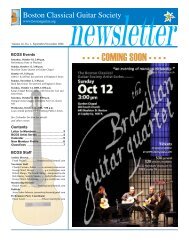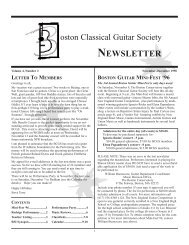2003 Jun-Aug - Boston Classical Guitar Society
2003 Jun-Aug - Boston Classical Guitar Society
2003 Jun-Aug - Boston Classical Guitar Society
You also want an ePaper? Increase the reach of your titles
YUMPU automatically turns print PDFs into web optimized ePapers that Google loves.
www.bostonguitar.org<br />
BCGS Newsletter<br />
Perspectives<br />
<strong>Jun</strong>e/<strong>Aug</strong>ust <strong>2003</strong><br />
Nail Break!<br />
by George Ward<br />
Natural guitar picks, fingernails, are constantly growing and<br />
require regular attention to produce a rich sound. That’s why<br />
they are a regular subject of conversation among guitarists. For<br />
some, maintenance is routine and presents no particular problem.<br />
If you’re one of these people, this article is not for you. It’s<br />
intended for the players who have high maintenance nails that<br />
split or break regularly.<br />
When it’s time to play or practice, a missing nail is devastating.<br />
Nothing feels or sounds right when there’s a hole in every<br />
arpeggio. Three nails are in plectrum heaven while the missing<br />
nail finger just swings in the breeze. Even when compensating<br />
the finger height over the strings, the muted sound of a fleshy<br />
fingertip is not consistent. I envy the steel string players.<br />
Broken nail? Just slide on a metal finger pic!<br />
I’ve been dealing with this issue from the first day I picked up<br />
the guitar. Length, shape, longevity, maintenance, repair, you<br />
name it, I’ve considered it! The following information is from<br />
my own experience and includes maintenance techniques with<br />
some options for dealing with a break. You may or may not be<br />
familiar with these techniques, some may not work for you, and<br />
some may totally revolt you!<br />
Nail shape and length issues are personal matters and not within<br />
the scope of this article. Each of us has a particular nail type<br />
along with preferences for length and shape. Articles abound on<br />
the web and almost every guitar technique book addresses the<br />
subject. My favorite is Scott Tennant’s article in Pumping<br />
Nylon. In it he illustrates several fingernail shapes and how to<br />
get the best tone from what you’ve got. He also recommends,<br />
interestingly enough, short nails! Maybe the simplest option is<br />
to just keep them shorter?<br />
In setting out to resolve nail break problems, the single most<br />
important thing I had to develop was the awareness of my fingers<br />
in everyday situations, and to simply be careful when<br />
doing small jobs around the house, handling tools, and yard<br />
work. It was also very important to stop using the fingernails as<br />
tools. You know, things like pressing the thumbnail into the<br />
plastic wrap of a CD then prying open the jewel case, ouch!<br />
Popping open a can of soda, or jamming your fingers against<br />
the door handle of a car. The next time you get into your car,<br />
take a close look at the recessed area around car door handle.<br />
See those scratches in the hard enamel paint? It’s your fingernails<br />
in action, protecting the tips and often cracking or splitting<br />
in the process, and how many days till your next gig?<br />
OVERVIEW<br />
To better understand the subject,<br />
take a look at Figure A. It shows<br />
the outside structure of a healthy<br />
fingernail. Its component parts<br />
are: the nail plate, nail fold<br />
(under the cuticle), cuticle, and<br />
lunula, the pale half moon. A<br />
normal fingernail grows at a rate<br />
of about 1/10 of a millimeter per<br />
day.<br />
Onychodermal<br />
band<br />
Nail<br />
plate<br />
Lateral nail fold<br />
Figure A<br />
Cuticle<br />
Cuticle<br />
Lunula<br />
Figure B, an internal view of the<br />
finger, shows the nail matrix that<br />
produces the keratin nail plate.<br />
The American Heritage<br />
Dictionary describes keratin as a<br />
tough protein substance that is a<br />
structural constituent of hair,<br />
Nail plate<br />
Bone<br />
Figure B<br />
nails, horns, and hooves. Our mythological connection to Pan?<br />
Proximal nail<br />
fold<br />
Proximal nail fold<br />
Matrix<br />
The matrix is the engine that extrudes the nail plate toward the<br />
tip and lies under the nail plate and proximal nail fold. The nail<br />
plate is our natural guitar pick and protects the finger in the<br />
event of a mild impact. But if the matrix is damaged or traumatized<br />
severely enough it will affect the nail where it is created,<br />
under the cuticle, Figure C. So<br />
it follows that if you whack your<br />
thumb or finger at the cuticle it<br />
Impact<br />
will create a dent (or worse, a<br />
split) in the nail plate, Figure D.<br />
This could take a month<br />
(depending on the length of the<br />
nail) to grow out, and when it<br />
Figure C<br />
finally reaches the tip, it will<br />
create an uneven edge against a<br />
Damaged nail plate<br />
guitar string until it finally<br />
grows past the tip to be trimmed<br />
off.<br />
Other problems like splitting and<br />
cracking can be caused by<br />
bumping the edge of a brittle<br />
Figure D<br />
nail against an object, or flaws in<br />
the grain of the nail plate from a permanently damaged matrix.<br />
Sometimes the tip of the nail will sustain a bang or bump and<br />
the force absorbed will split the nail across the grain, Figure F.<br />
This injury can be painful and may result in the split widening<br />
across the nail. Time for some help.<br />
9
















